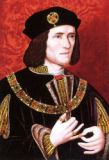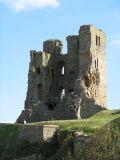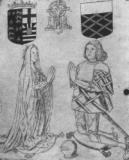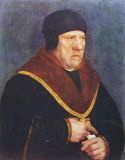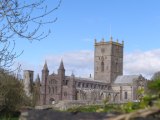The following article by Annette Carson, author of Richard III – The Maligned King, was originally published in the March 2012 issue of Ricardian Register, the journal of the American Branch of the Richard III Society. We are very grateful to Annette for making it available to our branch as well.
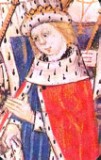 In the course of researching and writing my book about Richard III,1 I was struck by an apparently widespread assumption that the boy Edward V was sickly and, if not despatched by nefarious means, probably died of some kind of illness.
In the course of researching and writing my book about Richard III,1 I was struck by an apparently widespread assumption that the boy Edward V was sickly and, if not despatched by nefarious means, probably died of some kind of illness.
Leaving aside storytelling and wild speculation, there are very few respectable sources to which this misapprehension might be traced. Of these, only one was writing at the time of the events he described, and this was the Italian cleric Dominic Mancini, who reported that ‘like a victim prepared for sacrifice … [Edward] believed that death was facing him’.2
It is generally accepted that Mancini had come to England at the behest of his patron Archbishop Angelo Cato, a key figure in the intelligence-gathering circle of Louis XI of France. His visit coincided with a catastrophic breach in Anglo-French relations, on which Cato was doubtless looking for a first-hand report; instead of which Mancini found himself present during a far more interesting series of events: the death of Edward IV, the accession of his son, Edward V, and the latter’s replacement by Richard III.
Mancini gives a very full description of the twelve-year-old Edward V, his graces and accomplishments, physical appearance, whereabouts and general state of mind. This knowledge is attributed to his access to Dr John Argentine, the physician who attended Edward at his lodgings in the Tower of London after his deposition in the summer of 1483. With such a valuable and free-speaking source of information at hand, Mancini’s report would have been a poor effort indeed if he had not winkled out from the boy’s doctor all possible information about his health – a matter of great interest to the French court in those turbulent times, especially if he was ailing or even quite sick.
Yet Mancini’s comment about Edward’s daily confession ‘like a victim prepared for sacrifice’ is conspicuously devoid of reference to any issue of medical health, on which Argentine would have been the prevailing authority. Rather than suggesting that he was physically ill, it sounds like one of those hints Mancini likes to drop that young Edward was set to meet a sticky end.
Some 25 years later, the French chronicler Jean Molinet also wrote briefly of Edward V, describing him as ‘unsophisticated and very melancholy, aware only of the ill-will of his uncle’, a boy who believed that he and his brother were marked for death. Obviously coloured by the then-current assumption that they had been murdered by Richard III, Molinet’s retrospective account depicts Edward as a pathetic figure but undermines its own credibility with the adjective ‘unsophisticated’, which scarcely chimes with the admiring words of Dominic Mancini, who wrote (presumably quoting the physician Argentine): ‘In word and deed he gave so many proofs of his liberal education, of polite, nay scholarly attainments far beyond his age … his special knowledge of literature, which enabled him to discourse elegantly, to understand fully and to declaim most excellently from any work whether in verse or prose that came into his hands, unless it were from among the more abstruse authors’.3
While mentioning John Argentine, by the way, it need not be taken as significant that Edward’s doctor looked after him during his stay in London, as did also a number of other personal attendants, some of whose names are officially recorded. Rather it may be viewed as a sign of the appropriate care and respect given to his royal person. Indeed, since there is no contemporaneous account of his health, we should probably never have heard of his physician had not Mancini enjoyed Argentine’s confidences.
If Mancini’s observations are deficient in crucial specifics, our next source has even less factual evidence to offer. This is Sir George Buck in his History of King Richard the Third written in 1619, over 130 years later. Buck was Master of the Revels at the court of James I, and one of those seventeenth-century antiquaries who made it their business to delve into ancient papers in order to find documentary evidence about times past. Buck was a firm believer that the pretender known as ‘Perkin Warbeck’ was in fact Edward V’s younger brother, Richard. Of Edward he admitted knowing almost nothing, assuming that he must have fallen ill and died while still residing in the Tower of London: ‘[I think the elder] brother Edward died [of sick]ness and of infirmity (for he was weak and very sickly …)’.4
The best argument Sir George could find to support his theory was that Edward’s siblings did not live to make old bones: ‘their sisters also were but of a weak constitution, as their short lives showed.’ It is difficult to construe what kind of lifespan Buck termed ‘short’ for a woman, when death in childbirth was a constant hazard. Certainly some of the sisters lived into their late thirties, and Catherine, Countess of Devon, is said to have died in 1527, in her late forties. Their half-brother, Edward IV’s illegitimate son Lord Lisle, apparently lived to be nearly eighty.
Another basis for Buck’s theory was that no pretender came forward to represent himself as Edward V. This may be so, but very little is known about what lay behind the pretender later dubbed ‘Lambert Simnel’, crowned in Dublin in May of 1487, and supported by the Earl of Lincoln and Edward’s aunt Margaret of Burgundy (and even, perhaps, by his mother Elizabeth Woodville and half-brother Thomas, Marquess of Dorset). Buck may have fallen into the same error as have historians throughout the ages, i.e. the assumption that what he knew then was all there was to know.
Buck’s is the first recorded suggestion in so many words that Edward fell sick and died. But his book about Richard III cannot be said to have been widely read. Indeed for 350 years the only printed version was one in such a bowdlerized form that, until a scholarly edition of the original was produced by Arthur Kincaid in 1979, it was virtually dismissed by historians.
So, I wondered, could it be that the common supposition about Edward V’s ill-health dates from a source that is much more recent? I am referring to something that attracts considerable scepticism nowadays, and that is Lawrence Tanner and William Wright’s 1933 examination of those skeletal remains currently in Westminster Abbey which Charles II decided, in 1674, on no evidence whatsoever, were those of Edward V and his brother.5
The anatomist Professor Wright, and his dental adviser Dr George Northcroft – both of whom agreed enthusiastically with Charles II – identified evidence of a disease of the lower jaw in the elder of the two skulls present, which is visible in their published photographs. Thirty years later another anatomist, Dr Richard Lyne-Pirkis, gave a talk to the Richard III Society in which he stated it as his opinion, on the basis of those photographs, that it was probably ‘a condition known as osteomyelitis or chronic inflammation of the bone, which was quite a common condition in those days’.6 Osteomyelitis would have been extremely painful and increasingly disfiguring, and was very likely to have proved fatal in those centuries before antibiotics.
Other experts in a variety of disciplines have offered alternative diagnoses, the most popular being osteitis, an unpleasant and painful inflammatory disease, though not necessarily fatal in itself; unless, of course, it deteriorated into osteomyelitis.
The Tanner and Wright report concluded that the child whose skull they named ‘Edward V’ suffered from an extensive, chronic condition which had persisted for some years and had spread so far as to affect the temporo-mandibular joints. From the photographic evidence it can be seen to have produced destruction and malformation of areas of the affected bone. The owner of that jawbone would have suffered from inflamed, swollen and septic gums, as well as constant pain and discomfort. However, the problem remained that the Tanner and Wright examination, using the limited means at their disposal in 1933, failed to establish scientifically whether this owner was prince or pauper, boy or girl.7
It seemed to me that the vague assumptions I had encountered about Edward V’s illness must have been assimilated by a kind of reverse-engineering process: in other words, extrapolating backwards from the Tanner and Wright conclusions and superimposing them on to the remarks of writers like Mancini and Buck.
I have always favoured holding assumption up to the cold light of logic, so I decided to make the question of Edward V’s health, and the apparent link with the bones, one of a number of lines of original research that would be unique to my book.8 My starting point was to look at the phenomenon from the viewpoint of his contemporaries. Had a royal child suffered chronically in this way, it must have given rise to comment and concern. Doubtless he would have needed specially prepared food as the illness progressed and teeth were lost or removed. And he would have endured the never-ending attentions of not one but a team of physicians whose ministrations were probably quite as unpleasant as the disease itself.
Yet there is no contemporaneous hint of anything of the kind relating to Edward’s appearance or behaviour. As Prince of Wales he was constantly visible to members of his household, his retainers and the public at large from the age of three when he was first given his own council at Ludlow. As he grew older he was seen regularly at court and was exhibited by his father, Edward IV, to the gaze of his subjects on numerous public occasions.9
Furthermore, Dominic Mancini’s description of Edward at the age of twelve (shortly before his alleged death) speaks of ‘dignity in his whole person, and in his face such charm, that … he never wearied the eyes of beholders.’.10 If Edward had really been the owner of an infected and disfigured jaw, Mancini would surely have made certain in his report, delivered in December 1483, to remark less on the charm of his face and more on the cruelty and heartlessness of Richard III’s treatment of an ailing boy. This would have been music to the ears of Archbishop Cato and the French court, always looking for vulnerabilities in the English regime, especially as England’s most recent Parliament (under Edward IV) had voted funds for renewed Anglo-French hostilities. Yet Dominic Mancini suggests nothing of the sort.
Written material from the fifteenth century is admittedly scanty, and its paucity cannot be held to prove that Edward V was hale and hearty. However, it is equally incumbent on anyone who speaks of his ill-health to back it up with evidence.
It would be fair to expect an exhaustive examination of Edward V’s life and person in a biographical work, of which the only one yet published was written by Michael Hicks. Yet Hicks mentioned nothing of illness or disfigurement, and instead described him as ‘a very good-looking boy’. He also avoided almost all reference to the bones in Westminster Abbey, and on the two isolated occasions where they were briefly mentioned, he showed no sign of being convinced of their identity.11
To conclude my investigation from the standpoint of logic, I turned my thoughts to consideration of how the chronic ill-health of the Prince of Wales would have influenced the way his own heir presumptive – his younger brother – was raised and trained.
Given that diseases of the jaw were not uncommon in Edward’s day, it would certainly have been known that such a chronic infection could worsen progressively and even lead to death. Emotion played no part where questions of inheritance were concerned, and this was a matter that involved succession to the crown of England. Their father the king would surely have stopped at nothing to secure his Yorkist dynasty.
Yet no provision whatsoever seems to have been made for the younger boy, Richard, to receive appropriate training in kingly responsibility. Instead he remained at his mother’s side, never taking charge of his own household, even after the appointment of his own council in 1477. Neither was he placed under the tutelage of a suitable nobleman to learn the arts of arms and chivalry. In May 1483, when his brother arrived in London as king, Richard lurked with his mother in sanctuary.
Such lack of interest in preparing the younger brother for the possibility of kingship seems to point fairly conclusively, I would suggest, to absence of any concern for the health of the elder.
Postscript: There is still considerable room for research into the findings of Tanner and Wright, including the possibility of facial reconstruction, with which I have found it difficult to make progress. I hope to pursue this further now that I have taken up residence again in England.
ENDNOTES
1. Annette Carson, Richard III: The Maligned King (Stroud, 2008, 2009, 2010, 2011).
2. Dominic Mancini, De Occupatione Regni Anglie per Riccardum Tercium Libellus, ed. C.A.J. Armstrong (Gloucester, 1989) p.93.
3. Mancini, p.93.
4. Sir George Buck, The History of King Richard the Third (1619), ed. A.N. Kincaid (Gloucester, 1979) p.140.
5. Archaeologia LXXXIV, 1934.
6. Richard Lyne-Pirkis, Regarding the Bones Found in the Tower; speech given on 27 February 1963.
7. A survey of the principal academic commentaries devoted to the subject of the bones, whether by scientists or historians, can be found in Carson, pp.184-200, from which it will be seen that there is no consensus as to their identity, or sex, or age, or antiquity. What gives rise to most dubiety is that any attempt to calculate the age of the elder child is automatically stymied by the need to adjust computations to take account of retardation of development due to his or her chronic jaw disease, but nobody knows how much allowance to make.
8. For the record, examples of other matters explored in depth and generally overlooked by mainstream biographers include examination and reconstruction of the precise location at the Tower of London where the bones were found; a fresh look at the shifting allegiances which preceded the rebellion of October 1483; questions raised by the death of Edward IV; and Richard III’s proposed second marriage, particularly its implications as reflected in Elizabeth of York’s letter to the Duke of Norfolk.
9. Carson, p.190.
10. Mancini/Armstrong, p.93.
11. Michael Hicks, Edward V (Stroud, 2003) pp.176, 191.
© Annette Carson 2011
